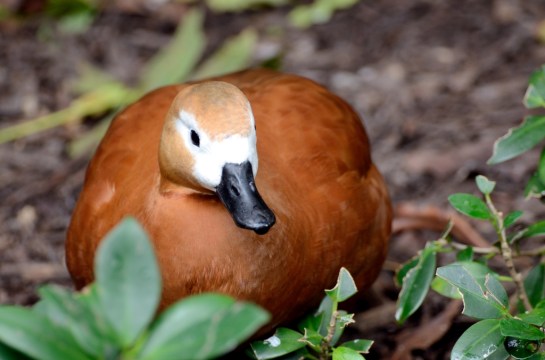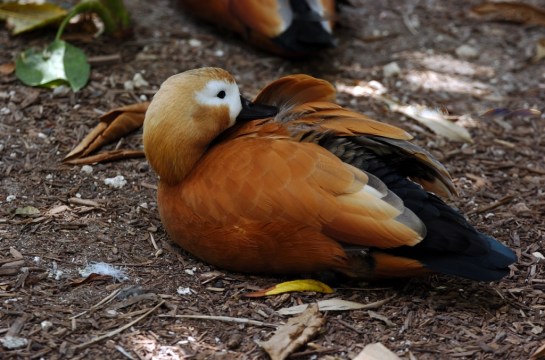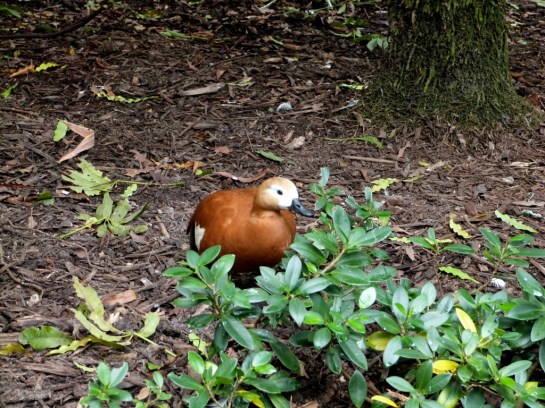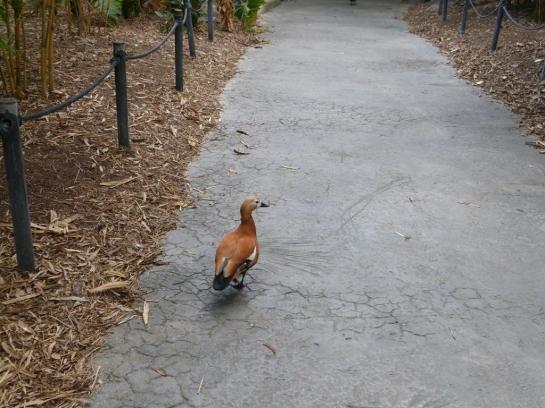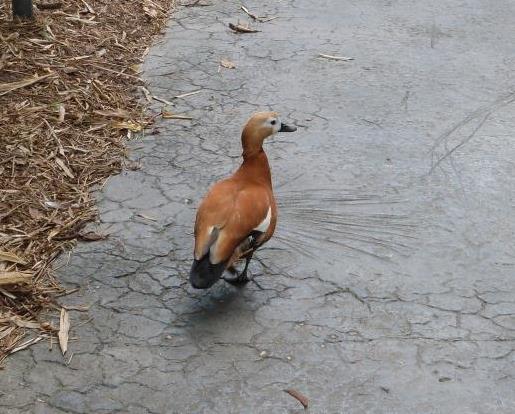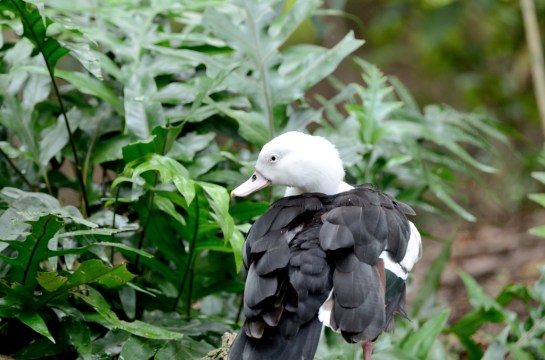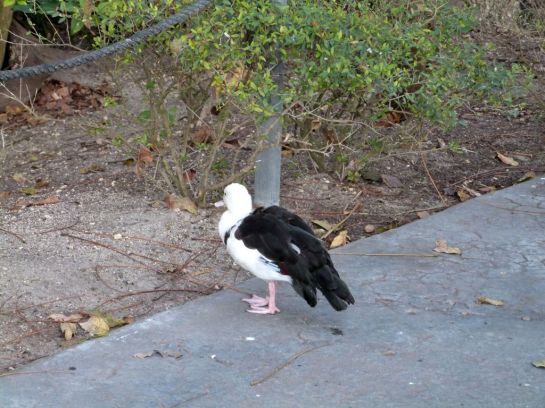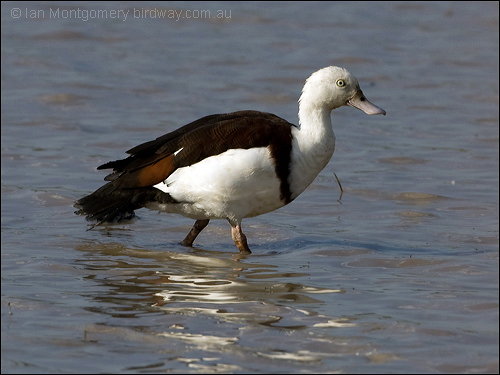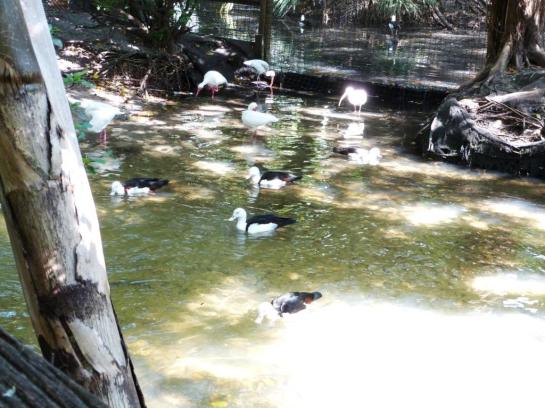We enjoyed our latest birdwatching adventure to Zoo Miami. Caught video of the Ruddy Shelducks discussing something. So this time we will share the two species of Shelducks at the Wings of Asia aviary. The Ruddy Shelduck (Tadorna ferruginea) and the Raja Shelduck (Tadorna radjah) are members of the duck, goose and swan family Anatidae – Ducks, Geese and Swans. They are in the shelduck subfamily Tadorninae. There are seven species in the Tadorninae subfamily. Wings of Asia has the Ruddy and Raja Shelducks.
Bless the LORD, O my soul. O LORD my God, thou art very great; thou art clothed with honour and majesty. (Psalms 104:1 KJV)
The Lord has provided for the Shelducks, as He does for all His critters. They are designed for the conditions they live in, in this case swimming, feeding and migrating, with beaks, feet, wings, and coloration to help them survive.
Ruddy – There are very small resident populations of this species in north west Africa and Ethiopia, but the main breeding area of this species is from southeast Europe across central Asia to Southeast Asia. These birds are mostly migratory, wintering in the Indian Subcontinent.
Facts:
- They are sometimes called Brahminy Ducks.
- Can be seen in many Zoos in America.
- In Tibet and Mongolia, Ruddy Shelduck is considered sacred by the Buddhists. It is also a sacred animal in Slavic mythology.
Although becoming quite rare in southeast Europe and southern Spain, the ruddy shelduck is still common across much of its Asian range. It may be this population which gives rise to vagrants as far west as Iceland, Great Britain and Ireland. However, since the European population is declining, it is likely that most occurrences in western Europe in recent decades are escapes or feral birds. Although this bird is observed in the wild from time to time in eastern North America, no evidence of a genuine vagrant has been found.
This is a bird of open country, and it will breed on cliffs, in burrows, tree holes or crevices distant from water, laying 6-16 creamy-white eggs, incubated for 30 days. The both shelduck is usually found in pairs or small groups and rarely forms large flocks. However, moulting and wintering gatherings on chosen lakes or slow rivers can be very large.
The ruddy shelduck is a distinctive species, 22.8-27.5 in (58-70) cm long with a 43-53 in (110–135 cm) wingspan. It has orange-brown body plumage and a paler head. The wings are white with black flight feathers. It swims well, and in flight looks heavy, more like a goose than a duck. The sexes of this striking species are similar, but the male has a black ring at the bottom of the neck in the breeding season summer, and the female often has a white face patch. The call is a loud wild honking.
Not sure what these Ruddy’s were debating about, but it seems the single one lost the discussion and left.
The ruddy shelduck is a common winter visitor in India. This bird is found in large wetlands, rivers with mud flats and shingle banks. Found in large congregation on lakes and reservoirs. It breeds in high altitude lakes and swamps in Jammu & Kashmir. Arrives in north India by October and departs by April. The genus name Tadorna comes from Celtic roots and means “pied waterfowl”, essentially the same as the English “shelduck”.
Raja Shelduck – The Radjah Shelduck (Tadorna radjah), is a species of shelduck found mostly in New Guinea and Australia, and also on some of the Moluccas. It is known alternatively as the raja shelduck (IOC Name), black-backed shelduck, or in Australia as the Burdekin duck.
The Raja Shelduck forms long-term pair-bonds, and is usually encountered in lone pairs or small flocks. During the wet season the males commonly become very irritable, and have been observed attacking their mates.
The diet consists mainly of mollusks, insects, sedge materials and algae. Pairs start searching for nesting sites during the months of January and February. They nest close to their primary food source, often in the hollow limbs of trees, which makes habitat destruction a particular issue.
The radjah shelduck does not use nesting materials except for some self-supplied down feathers. Egg-laying is usually done by May or June, but depends on the extent of the wet season. The clutches range from 6 to 12 eggs. Incubation time is about 30 days. (Wikipedia edited)
Here are photos of both Shelducks. Some of the photos are from other trips and some from Ian. (PBZ is Palm Beach Zoo)
- Ruddy Shelduck (Tadorna ferruginea) at Wings of Asia by Dan
- Ruddy Shelduck (Tadorna ferruginea) at Wings of Asia by Dan
- Ruddy Shelduck (Tadorna ferruginea) at Wings of Asia by Lee
- Ruddy Shelduck (Tadorna ferruginea) at Wings of Asia by Lee
- Ruddy Shelduck (Tadorna ferruginea) at Wings of Asia by Dan
- Ruddy Shelduck (Tadorna ferruginea) by Dan at Zoo Miami
- Ruddy Shelduck (Tadorna ferruginea) Zoo Miami by Lee
- Ruddy Shelduck (Tadorna ferruginea) at Wings of Asia by Lee
- Ruddy Shelduck (Tadorna ferruginea) by Lee ZM
- Raja Shelduck (Tadorna radjah) by Dan at Zoo Miami
- Raja Shelduck (Tadorna radjah) at Wing of Asia by Dan
- Raja Shelduck (Tadorna radjah) at Wing of Asia by Dan
- Raja Shelduck (Tadorna radjah) at Wing of Asia by Dan
- Raja Shelduck (Tadorna radjah) Zoo Miami by Lee
- Raja Shelduck showing collar by Ian
- Raja Shelduck (Tadorna radjah) by Ian
- Raja Shelduck at Wings of Asia by Lee
- Rajah Shelduck at PBZ by Lee
- Rajah Shelduck at PBZ by Lee
- Rajah Shelduck at PBZ by Lee
- Rajah Shelduck at PBZ by Lee
- Ruddy Shelduck – Wikipedia
- Ruddy Shelduck – ARKive
- Ruddy Shelduck
- Ruddy Shelduck – Animals, Animals (nice flying photo)
- Radjah Shelduck – Utah Zoo
- Radjah Shelduck – Wikipedia
- Shelduck – Wikipedia
- Anatidae – Ducks, Geese and Swans Family
- Birdwatching Trips
- Zoo Miami and the Wings of Asia
*




